Unveiling the Secrets of Longevity: Fermented Cereals and Gerobiotic Cocktails
2024-06-07 18:35
The quest to understand and promote healthy aging has captivated scientists for decades. Among the various approaches, dietary interventions, particularly those involving probiotics, have emerged as promising avenues. This study, published in the journal of Food & Function by the Royal Society of Chemistry, explores the potential of fermented cereal-origin gerobiotic cocktails in extending lifespan and improving healthspan in the nematode Caenorhabditis elegans.
Probiotics, live microorganisms that confer health benefits upon consumption, have been linked to various health improvements, including modulation of the gut microbiome and enhanced stress tolerance. Gerobiotic interventions, however, take this a step further. They combine probiotics with prebiotics—nutrients that serve as food for these beneficial microbes—fostering a symbiotic relationship within the gut. Govindhan et al. delves into the power of multi-strain gerobiotic cocktails. While single-strain probiotics have shown efficacy in promoting longevity across species, the authors highlight the potential benefits of combining multiple strains. These combinations can exploit synergistic effects, where the combined action of multiple strains surpasses the effects of individual strains alone.
The researchers commenced by isolating and characterizing probiotic bacteria from traditionally fermented barnyard millet (Figure 1). This ancient grain, known for its nutritional value, undergoes a natural fermentation process that harbors diverse microbial communities. From a pool of 120 isolates, the team employed a combination of techniques, including growth profiling and enzymatic activity assays, to select potential candidates for their gerobiotic cocktails.
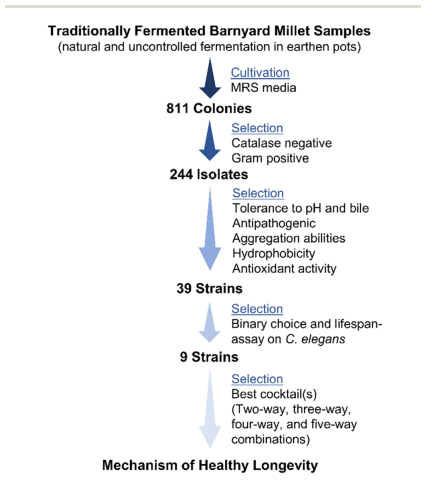
Figure 1. Flowchart depicting the isolation and selection of fermented cereal-origin probiotic bacteria used in the present study.
The next step involved evaluating the impact of these gerobiotic cocktails on the lifespan of C. elegans. This nematode serves as a well-established model organism in aging research due to its relatively short lifespan, genetic tractability, and well-characterized aging pathways. C. elegans were exposed to various combinations of the isolated bacterial strains throughout their lifespan. Remarkably, the study identified two particularly effective gerobiotic cocktails:
Cocktail 55: This combination comprised Bacillus licheniformis PS70, Lactobacillus delbrueckii subsp. bulgaricus PS77, and Leuconostoc amylovorus PS60. It resulted in a staggering 46.2% increase in the mean lifespan of C. elegans compared to the control group.
Cocktail 112: This cocktail, containing L. delbrueckii subsp. bulgaricus PS77, Lactococcus lactis PS10, and Pediococcus pentosaceus PS91, achieved an even greater increase in lifespan, extending it by an impressive 53.1% (Figure 2).
Intriguingly, not all combinations yielded positive results. This observation underscores the strain-specific nature of gerobiotic interventions. The specific bacterial makeup of the cocktail significantly influenced its impact on lifespan. This highlights the importance of careful selection and optimization of strains for gerobiotic formulations.
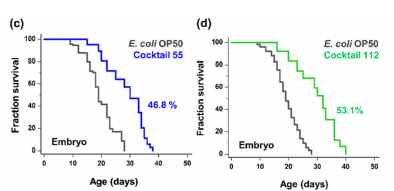
Figure 2. The effects of cocktail 55 and cocktail 112 on extending worm lifespan.
The study by Govindhan et al. delves deeper than just lifespan extension, exploring how gerobiotic cocktails impact healthspan in C. elegans. Healthspan refers to the period of healthy living within an organism's lifespan. Evaluating various markers associated with aging and health, the researchers observed significant improvements in the C. elegans treated with gerobiotic cocktails.
One key healthspan marker is pharyngeal pumping rate, a metric that reflects feeding efficiency and overall health in C. elegans. The study found that worms treated with both cocktail 55 and cocktail 112 exhibited a significantly higher pharyngeal pumping rate compared to the control group throughout their lifespan (Figure 3). Notably, the age-related decline in pumping rate observed in the control group was largely mitigated in the gerobiotic cocktail-treated worms. This suggests that the cocktails promoted a more youthful feeding behavior, potentially contributing to improved nutrient uptake and overall health.
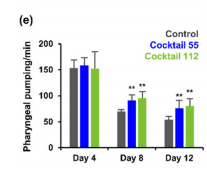
Figure 3. Worms treated with both cocktail 55 and cocktail 112 exhibited a significantly higher pharyngeal pumping rate.
Another healthspan marker investigated was body movement. Age-related decline in mobility is a hallmark of aging in C. elegans, as well as in humans. The study revealed that worms treated with gerobiotic cocktails displayed significantly enhanced body movement compared to the control group (Figure 4). This indicates that the cocktails may help maintain neuromuscular function and promote physical fitness during aging.
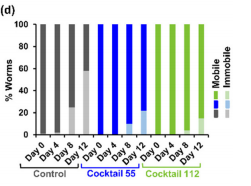
Figure 4. Worms treated with gerobiotic cocktails displayed significantly enhanced body movement.
Stress tolerance is another crucial aspect of healthspan. Sensitivity to thermal stress was determined by assessing the survival of worms incubated at 35 °C for 3 h. Worms treated with gerobiotic cocktails exhibited significantly increased resistance to heat shock compared to the control group (Figure 5). This suggests that the cocktails enhance the worms' ability to cope with environmental stressors, potentially contributing to a more resilient and adaptable organism.
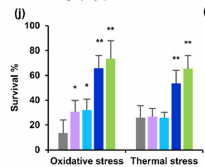
Figure 5. Worms fed gerobiotic cocktails 55 and 112 showed significantly higher survival rates than those fed with E. coli, OP50, following exposure to lethal thermal and oxidative stresses.
To understand how gerobiotic cocktails promote longevity and enhance healthspan, the researchers investigated their influence on specific signaling pathways within C. elegans. These pathways act as intricate communication networks within the organism, regulating various cellular processes, including stress responses, metabolism, and longevity.
Cocktail 55 appeared to exert its lifespan-extending effects through the p38 MAPK-SKN-1 pathway. The p38 MAPK pathway is a well-characterized stress-responsive pathway known to be involved in regulating lifespan in C. elegans. The SKN-1 transcription factor acts downstream of the p38 MAPK pathway and plays a critical role in promoting stress resistance and longevity. The study suggests that cocktail 55 may activate this pathway, leading to increased expression of SKN-1 and ultimately promoting longevity (Figure 6).
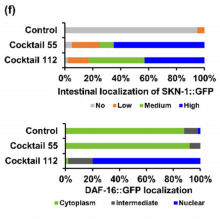
Figure 6. Increased expression of SKN-1 seen in worms treated with cocktail 55.
Cocktail 112 seemed to function through a more complex mechanism, influencing multiple signaling pathways. One key pathway involved is the insulin/IGF-1 signaling (IIS) pathway, a highly conserved pathway across species that plays a crucial role in regulating metabolism, growth, and lifespan. The study found that cocktail 112 treatment down-regulated the activity of the IIS pathway in C. elegans (Figure 7). Down-regulation of the IIS pathway is a known mechanism associated with lifespan extension in various organisms, including C. elegans. This suggests that cocktail 112 may promote longevity by modulating the IIS pathway. Another pathway potentially influenced by cocktail 112 is the β-catenin pathway,which is involved in various cellular processes, including cell proliferation and differentiation. The study observed that gerobiotic cocktail 112 treatment led to a decrease in β-catenin levels in C. elegans. This suggests that the cocktail may modulate this pathway, potentially contributing to its beneficial effects on longevity and healthspan. Finally, the TGF-β pathway, which plays a role in regulating stress responses and cellular differentiation, also emerged as a potential target of cocktail 112. The study found that gerobiotic cocktail 112 treatment altered the expression of specific genes associated with the TGF-β pathway in C. elegans. While the precise role of this pathway in the context of the gerobiotic cocktails remains to be elucidated, it suggests a potentially multifaceted mechanism of action for cocktail 112.
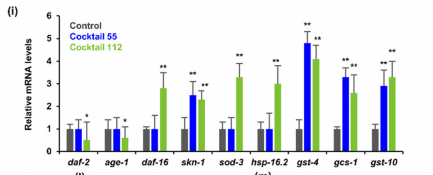
Figure 7. Cocktail 112 feeding up-regulates the mRNA levels of daf-16, sod-3, hsp-16.2, skn-1, gst-4, gcs-1, and gst-10, but down-regulates the relative expression levels of daf-2 and age-1.
This study provides evidence for the potential the potential of fermented cereal-derived gerobiotic cocktails in promoting healthy aging. The significant lifespan extension and improved healthspan markers observed in C. elegans warrant further investigation. While the findings in C. elegans are promising, translating these results to human health still requires further research. Future studies should explore the efficacy and safety of gerobiotic cocktails derived from fermented cereals in mammalian models. Additionally, clinical trials are necessary to determine the effectiveness of these cocktails in promoting healthy aging in humans. The specific bacterial strains identified in this study can serve as a foundation for developing targeted gerobiotic formulations. Understanding the mechanisms by which these cocktails promote longevity and enhance healthspan can guide the development of more potent and optimized gerobiotic interventions.
Reference: Govindhan, Thiruppathi, et al. "Fermented cereal-origin gerobiotic cocktails promote healthy longevity in Caenorhabditis elegans." Food & Function 14, no. 23 (2023): 10430-10442. doi:10.1039/d3fo02984k
Keywords: C.elegans, probiotics, prebiotics, gerobiotic cocktails, longevity









